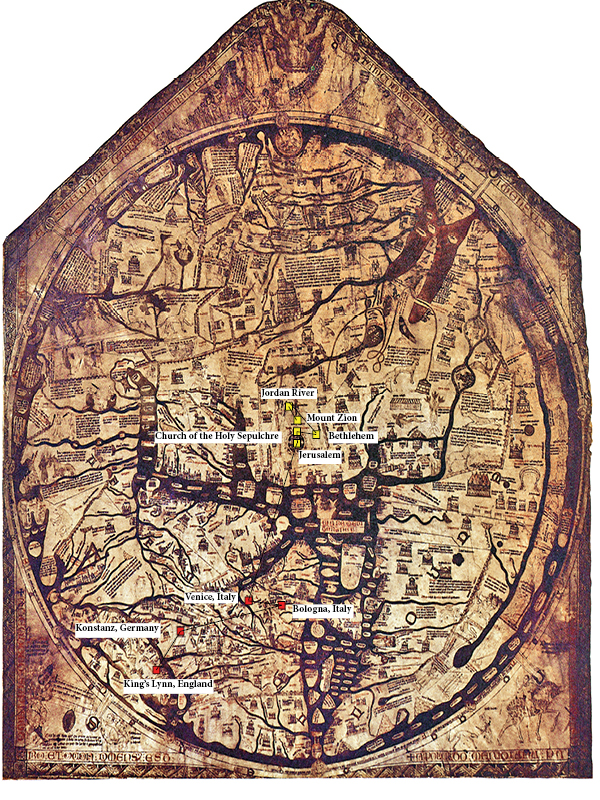Upon mapping 10 points of Benjamin of Tudela’s journey on a modern map, and then re-mapping the same points on the medieval Tabula Rogeriana map, one can’t help but notice the similarities between both routes. From first glance, the Tabula Rogeriana map appears to be incorrect geographically-speaking: what we consider to be North today is depicted as the opposite on this map and the ratio between land and sea is disproportionate. Yet, if one were to rotate the Tabula Rogeriana map to be upside-down, or rather right-side up for modern day viewers, Benjamin’s route appears to be almost identical to that which was mapped on a modern map. These points were extremely difficult to find given that the Tabula Rogeriana map was written in Arabic. That said, it was more manageable to find all of my points by first finding larger cities such as Mecca and then Jerusalem and then reorienting myself based on the location of those cities.
What is different however, is the detailed layout of the land on the Tabula Rogeriana map. It would make sense that the outskirts of the Tabula Rogeriana map are not correct as little to no medieval travelers treaded so far North, East and South, but it is similarly clear that the lands more populated at the time were not thoroughly traveled nor documented either. This would account for the bizarre and misshapen outlines of the countries surrounding the Mediterranean Sea.
For instance, when looking at the Tabula Rogeriana, Rome and Istanbul appear to be located in their rightful places, but the land that separates them is not. It is known from Benjamin’s travel narrative that he traveled first from Rome to Greece, and then Greece to Turkey, crossing the different bodies of the Mediterranean Sea along the way. Yet, if one were to consult the Tabula Rogeriana instead, it would appear that Benjamin travelled from Rome to Turkey simply by remaining close to the shorelines on his left and not by crossing through the ocean that separates Italy from Greece.
Furthermore, when comparing Benjamin’s route on the Tabula Rogeriana map and on the modern map, the two routes are very similar. It should also be noted that the cities Benjamin traveled to were relatively close in distance and his route on the Tabula Rogeriana map seems to form a logical loop from Rome to Alexandria —which was back towards where he had started. Like on the modern map, the Tabula Rogeriana map reveals (through the green labeling of water and the blue/white squiggles of ocean) that Benjamin was indeed traveling by boat through water-ways to reach each of the locations he documented having travelled to. This leads me to question the verity of this account of having traveled eastward towards Tibet and China, however the water-ways marked on the Tabula Rogeriana map would still support this route.
In conclusion, if Benjamin really had travelled all the way out to Tibet and India before heading back towards Alexandria, Egypt, the Tabula Rogeriana map would still have been able to guide him toward the places he sought to visit. Regardless of the medieval map’s errors, the demarcations of land and sea relative to the locations Benjamin traveled to were relatively accurate.
